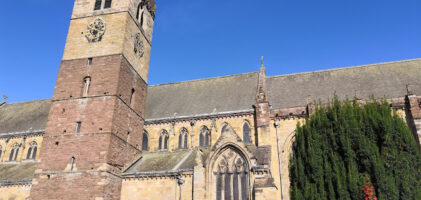
The Cathedral of Dunblane is one easily missed, if you don’t know the beauty of Dunblane you might hesitate to pay it a visit, but it is definitely a place worth the time.
Dunblane (meadow of Blane) is thought to come from the site being used by monks from St Blane’s. Who were fleeing to the Isle of Bute with all their saint’s relics when the Viking started raiding the lands.

Dunblane Cathedral itself stands on a sacred place, which was worshiped as such for over 1,000 years. Its exterior is Gothic which has been restored in the 19th-century.

When looking at the Cathedral you might realise that the tower, built of red sandstone, sits in a strange angle to the church, which was built later than the remaining tower. The chancel of the cathedral was used for worship till 1886 until it was said to be too small. In 1889 the ruined nave was restored by Robert Rowand Anderson, with the weathered medieval stonework being retained.

These days the church is used as a place of worship but also contains Pictish carved stones, rare choir stalls from 15th-century and 19th-century church furnishings.

As mentioned before, the site of the Cathedral has been worshiped for hundreds of years. Dating back to the 7th or 8th century, two cross-slabs were found, suggesting Christian presence at that time and opens the idea of a religious centre which would date back till at least the 9th century.
In 1155 a bishop at Dunblane has been first mentioned after the return of the bishopric and the first cathedral being built which stayed unroofed till 1237, when Bishop Cement secured papal approval for building a bigger new cathedral, replacing the old one.


Dunblane Cathedral, as many others was affected by the Protestant Reformation of 1560. The Protestants took down the interior furnishings and the responsibility for public worship was taken over by a reformed minister, the public worship was confined to the chapel, which left the nave to fall into decay, resulting of that, the roof collapsed in 1622.

Nearly 200 years later James Gillespie Graham restored the chancel in 1816, but by 1886 the capacity of the cathedral had been deemed insufficient. Which led to the restoration of the nave by Robert Rowand Anderson. It took about another 26 years before the choir stalls and elaborate pews were added in 1912 and 1914.

The most recent part of the cathedral is the addition of a memorial located in the south aisle, which has been created for the victims of the 1996 Dunblane massacre.
For additional information:
The Dunblane massacre took place at Dunblane Primary School on 13th March 1996. Thomas Hamilton shot sixteen pupils and one teacher dead, injuring many others, before he killed himself. The Massacre remains the deadliest mass shooting in British history and one of the saddest when remembering that the victims were mainly children not older than 12 years.

